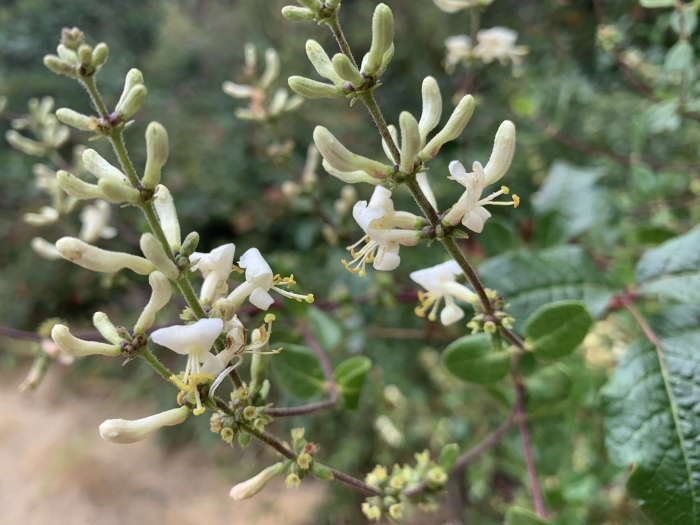Southern Honeysuckle
(Lonicera subspicata)
Southern Honeysuckle (Lonicera subspicata)
/
/

Eric Alan Isaacson
CC BY 4.0
Image By:
Eric Alan Isaacson
Recorded By:
Copyright:
CC BY 4.0
Copyright Notice:
Photo by: Eric Alan Isaacson | License Type: CC BY 4.0 | License URL: http://creativecommons.org/licenses/by/4.0/ | Rights Holder: Eric Alan Isaacson | Publisher: iNaturalist | Date Created: 2020-06-20T17:27:13Z |






























































Estimated Native Range
Summary
Lonicera subspicata, commonly known as Southern Honeysuckle, is an evergreen perennial vine or shrub native to the coastal sage scrub and chaparral of California and Baja California. This species often grows twining or reclining on shrubs and can reach lengths of 90 to 240 centimeters. Its inflorescences are long, fuzzy spikes of light yellow flowers, each about a centimeter long, with a two-lipped corolla that is 8 to 12 mm in length, pale yellow, and frequently hairy. The stamens and style protrude and are also hairy. The fruit is a red or yellow berry, approximately 8 mm in size, with the variety denudata producing edible berries.
Southern Honeysuckle is valued for its drought tolerance and ability to cover low fences or the north side of a building, providing a lush appearance with minimal water requirements. It can climb if given support and is cold hardy to -4 degrees Celsius (25 degrees Fahrenheit). In cultivation, it thrives in full sun to part shade and prefers soils with medium drainage. While it is not commonly used for culinary purposes, the edible berries of the variety denudata can be an interesting feature. Gardeners should note that while it is drought-tolerant, it may require more frequent watering during establishment or in extremely dry conditions.CC BY-SA 4.0
Southern Honeysuckle is valued for its drought tolerance and ability to cover low fences or the north side of a building, providing a lush appearance with minimal water requirements. It can climb if given support and is cold hardy to -4 degrees Celsius (25 degrees Fahrenheit). In cultivation, it thrives in full sun to part shade and prefers soils with medium drainage. While it is not commonly used for culinary purposes, the edible berries of the variety denudata can be an interesting feature. Gardeners should note that while it is drought-tolerant, it may require more frequent watering during establishment or in extremely dry conditions.CC BY-SA 4.0
Plant Description
- Plant Type: Shrub, Vine
- Height: 3-6 feet
- Width: 2-3 feet
- Growth Rate: Moderate
- Flower Color: Cream, White
- Flowering Season: Spring, Summer, Fall
- Leaf Retention: Evergreen
Growth Requirements
- Sun: Full Sun, Part Shade
- Water: Low
- Drainage: Medium
Common Uses
Bee Garden, Bird Garden, Butterfly Garden, Deer Resistant, Drought Tolerant, Fragrant, Groundcover, Hummingbird Garden, Low Maintenance, Showy Flowers
Natural Habitat
Native to the coastal sage scrub and chaparral of California and Baja California
Other Names
Common Names:
Scientific Names: Lonicera subspicata , Lonicera subspicata var. subspicata , Lonicera hispidula var. subspicata , Lonicera interrupta var. subspicata
GBIF Accepted Name: Lonicera subspicata Hook. & Arn.